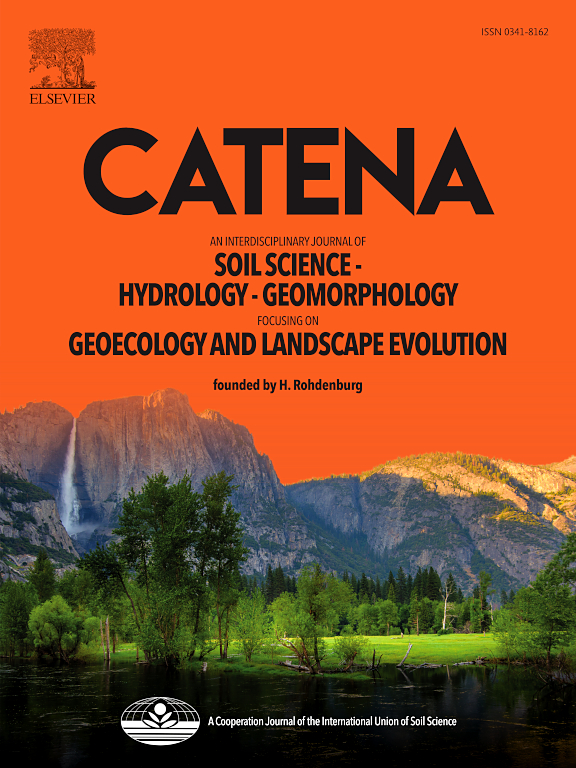地中海流域化学风化的水文和大气CO2消耗
IF 5.7
1区 农林科学
Q1 GEOSCIENCES, MULTIDISCIPLINARY
引用次数: 0
摘要
碳酸盐和硅酸盐的化学风化作用消耗大气CO2,增加河流溶解负荷,是重要的碳汇。虽然碳酸盐和硅酸盐风化都有助于短期的二氧化碳吸收,但只有硅酸盐风化会导致长期的二氧化碳消耗。非碳酸盐成分的岩性对大气CO2消耗的影响已经在文献中进行了探讨。然而,需要进一步的研究来量化硅酸盐岩石中碳酸盐矿物对风化速率的贡献,并与纯碳酸盐岩石进行比较。此外,水文(如水流变化)和地貌(如侵蚀)过程与化学风化的相互作用仍然存在争议。在意大利中部主要由硅质碎屑沉积岩组成的Niccone流域,我们测量了不同水流条件下的溶解和悬浮载荷(化学风化和侵蚀的代用物)。溶解负荷通过测量水体碱度和电导率估算,悬浮负荷通过DH-59泥沙采样器测量。这项工作的目的是调查和量化Niccone流域混合沉积岩(即非纯碳酸盐)露头中包含的小百分比碳酸盐矿物如何在短时间尺度上影响大气二氧化碳消耗率,并评估水文和地貌因素(如径流和侵蚀)对这些速率的影响。为了实现这一点,我们还估计了溪流流域内露头岩石中碳酸盐矿物的百分比。我们发现离子浓度具有化学平衡行为,与流速相比变化要小得多。化学风化和侵蚀在较低的侵蚀速率下表现为线性结垢,因为侵蚀暴露的反应物质相对较多。在较高的侵蚀速率下,可以观察到风化产物的逐渐增加,因为相对于它们发生反应的速率,矿物质的供应过剩。我们还估计了化学风化所消耗的大气CO2随径流的变化。数据使我们能够量化Niccone流域不可忽略的碳酸盐成分(少于20%),从二氧化碳消耗的角度来看,这是重要的,尽管硅质岩石在大部分研究区域占主导地位。这一发现可能会挑战一些仅基于岩性信息的大气二氧化碳消耗的大规模估计。本文章由计算机程序翻译,如有差异,请以英文原文为准。
Hydrology and atmospheric CO2 consumption by chemical weathering in a Mediterranean watershed
Chemical weathering of carbonates and silicates is an important sink of carbon as it consumes atmospheric CO2 increasing river dissolved load. While both carbonate and silicate weathering contribute to short-term CO2 uptake, only silicate weathering drives long-term CO2 consumption.
The influence of lithologies with a non-dominant carbonate component on atmospheric CO2 consumption has been explored in the literature. However, further research is needed to quantify the contribution of carbonate minerals within silicate rocks to weathering rates in comparison to those of pure carbonate rocks. Furthermore, the interactions that hydrological (e.g. streamflow variation) and geomorphological (e.g. erosion) processes have with chemical weathering remain controversial.
We measured at different streamflow conditions the dissolved and suspended loads (proxies of chemical weathering and erosion) in the Niccone watershed (Central Italy) composed mainly of siliciclastic sedimentary rocks. The dissolved load was estimated by measuring stream water alkalinity and electrical conductivity, and the suspended load was measured by using the DH-59 sediment sampler. The aim of this work is to investigate and quantify how the small percentages of carbonate minerals, included in the mixed sedimentary rocks (i.e. non-pure carbonate) outcropping in the Niccone watershed, influence the atmospheric CO2 consumption rates over short timescales and to evaluate the influence of hydrological and geomorphological factors, such as runoff and erosion, on these rates. To achieve this, we also estimated the percentage of carbonate minerals present in the outcropping rocks within the stream watershed.
We found a chemostatic behavior in the ionic concentration, with much less variation compared to the flow rate. Chemical weathering and erosion exhibit a linear scaling at lower erosion rates given the relatively larger quantity of material for reactions exposed by erosion. At higher erosion rates, a gradual increase in weathering products is observed, as minerals are provided in excess relative to the rate at which they undergo reactions. We also estimated the variation with runoff of the atmospheric CO2 consumed by chemical weathering.
Data enabled us to quantify a non-negligible carbonate component (less than 20%) in the Niccone watershed, significant from a CO2 consumption perspective, despite siliciclastic rocks predominating across most of the study area. This finding may challenge some large-scale estimates of atmospheric CO2 consumption based solely on lithological information.
求助全文
通过发布文献求助,成功后即可免费获取论文全文。
去求助
来源期刊

Catena
环境科学-地球科学综合
CiteScore
10.50
自引率
9.70%
发文量
816
审稿时长
54 days
期刊介绍:
Catena publishes papers describing original field and laboratory investigations and reviews on geoecology and landscape evolution with emphasis on interdisciplinary aspects of soil science, hydrology and geomorphology. It aims to disseminate new knowledge and foster better understanding of the physical environment, of evolutionary sequences that have resulted in past and current landscapes, and of the natural processes that are likely to determine the fate of our terrestrial environment.
Papers within any one of the above topics are welcome provided they are of sufficiently wide interest and relevance.
 求助内容:
求助内容: 应助结果提醒方式:
应助结果提醒方式:


